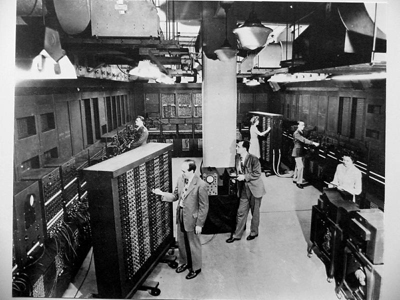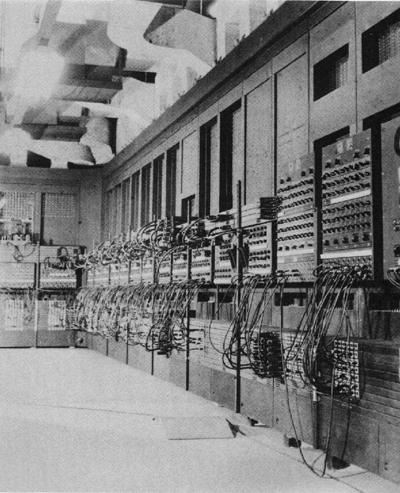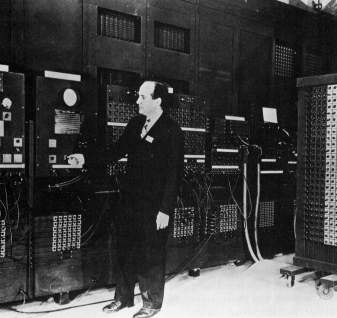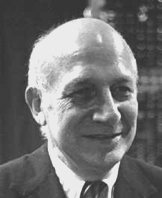From ENIAC to Everyone: Talking with J. Presper Eckert
February 23, 2006 by Alexander Randall 5th
J. Presper Eckert reveals the inside story of the invention of ENIAC, the first practical, all-electronic computer, and debunks some myths in this forgotten interview. “It is shocking to have your life work reduced to a tenth of a square inch of silicon,” he said.
Published on KurzweilAI.net February 23, 2006.
There are two epochs in computer history: Before ENIAC and After ENIAC. The first practical, all-electronic computer was unveiled on February 13, 1946 at the Univ. of Pennsylvania’s Moore School of Electronics. While there are controversies over who invented what, there is universal agreement that the ENIAC was the watershed project that showed electronic computing was possible. It was a masterpiece of electrical engineering, with unprecedented reliability and speed. And the two men most responsible for its success were J. Presper Eckert and John W. Mauchly.
I recorded two days of interviews with J. Presper Eckert in 1989. He was 70 years old. My father was Pres’ best friend from childhood and I’d spent my childhood playing with his children. I visited him regularly as an adult. On that day, we spoke in his living room in Gladwyne Pennsylvania—most of it spent sitting on the floor. We stopped talking about computers only to fiddle with his Nova Chord electronic organ that predated ENIAC and we fiddled with stereo speakers. On a second occasion, I recorded a conversation at his daughter’s home in western Massachusetts.
Calculating Machines Before ENIAC
Randall: How did the calculating machines before ENIAC work?
Eckert: Well, a person with a paper and pencil can add two 10-digit numbers in about 10 seconds. With a hand calculator, the time is down to 4 seconds. The Harvard Mark 1 was the last of the electromechanical computers—it could add two 10-digit numbers in 0.3 seconds about 30 times faster than paper and pencil. When I was a graduate student, the Moore School of Electronics had two analyzers that were essentially copies of Vannevar Bush’s machine from MIT.
Randall: What could that machine do?
Eckert: It could solve linear differential equations but only linear equations. It has a long framework divided into sections with a couple dozen shafts buried through it. You could put different gears on the shafts using screwdrivers and hammers and it had "integrators" that gave the product of two shafts coming in on a third shaft coming out. By picking the right gear ratio, you should get the right constants in the equation. We used published tables to pick the gear ratios to get whatever number you wanted. The limit on accuracy of this machine was the slippage of the mechanical wheels on the integrator. That made me say, "Let’s build electronic integrators and stick them into this machine instead of those wheel things." We added several dozen motors and amplifiers and circuits using over 400 vacuum tubes, which as electronic things go, is not trivial. The radio has only five or six tubes, and television sets have up to 30. The Nova Chord organ was built prior to this and it has about 170 tubes. The Bush Analyzer was still essentially a mechanical device.

ENIAC, which debuted 60 years ago, had 18,000 vacuum tubes.
That led me to examine if I could find some way to multiply pulse numbers together so I don’t need gears—then I could do the whole thing electrically. There’s a theorem in calculus where you can use two integrators to do a multiplication. I talked with John Mauchley about it. Just who put in which part is hard to tell, but the idea of doing the integrations by counters was mine.
"The first real use was Edward Teller using ENIAC to do calculations for the Hydrogen bomb."
The ENIAC (Electrical Numerical Integrator And Calculator) was the first electronic digital computer and could add those two 10 digit numbers in .0002 seconds—that’s 50,000 times faster than a human, 20,000 times faster than a calculator and 1500 times faster than the Mark 1. For specialized scientific calculations it was even faster.
Randall: So it’s a myth that ENIAC could only add, subtract, multiply and divide….
Eckert: No, that’s a calculator. ENIAC could do three-dimensional second-order differential equation. We were calculating trajectory tables for the war effort. In those days the trajectory tables were calculated by hundreds of people operating desk calculators—people who were called "computers." So the machine that does that work was called a "Computer."
Visions of ENIAC
Randall: So what did they give you? Did they say, "Here’s a room? Here are some tools. Here are some guys—go make it?”
Eckert: Un Huh. Pretty much.
Randall: What did ENIAC’s room look like?
Eckert: We built ENIAC in a room that was 30 feet by 50 feet. At the Moore School in West Philadelphia on the first floor.
Randall: There is a story that ENIAC dimmed the lights in Philadelphia when it was in use.
Eckert: That story is total fiction, dreamed up by some journalist. We took power off of the grid. We had voltage regulators to provide 150 kilowatts of regulated supply.
Randall: Did the military guys working on ENIAC salute the machine?
Eckert: Another ENIAC myth.
Randall: You said the largest tube gadget in 1943 was the Nova Chord with 170 tubes… what did ENIAC use?
Eckert: ENIAC had 18,000 vacuum tubes. The tubes were off the shelf; we got whatever the distributor could supply in lots of a thousand. We used 10 tube types, but could have done it with 4 tubes types; we just couldn’t get enough of them. We decided that our tube filaments would last a lot longer if we kept them below their proper voltage. Not too high or too low. A lot of the circuits were off the shelf, but I invented a lot of the circuits as well. Registers were a new idea. So were integrator circuits.
The function of the machine was split into eight basic circuit components: the accumulator, initiator, master programmer, multiplier, divider/square-root, gate, buffer, and the function tables. The accumulator was the basic arithmetic unit of the ENIAC. It consisted of twenty registers, each ten digits wide, which performed addition, subtraction, and temporary storage. The accumulator can be compared to the registers in today’s central processing units.
State of the Invention
Randall: Are there any of your circuits still in use in today’s personal computers…
Eckert: No, but that’s true of any first invention. Edison’s original light bulb bears no resemblance to a modern bulb. They do the same thing but with totally different components. Same with the computer. What did survive were the concepts, not the hardware. The idea of a subroutine was original with ENIAC. Mauchly had this idea based on his knowledge of the inner workings of desk calculators and introduced me to his idea for a subroutine in the machine. On Mark 1, if they wanted to do a calculation over and over, they had to feed the same tape in over and over. We invented ways to run the same subroutine without any mechanical input. The idea of using internal memory was also original with ENIAC.
Randall: There’s a story that some guy was running around with a box of tubes and had to change one every few minutes.

Eckert: Another myth. We had a tubes fail every about every two days and we could locate the problem within 15 minutes. We invented a scheme to build the computer on removable chassis—plug in components—so when tubes failed we could swap them out in seconds. We carried out a very radical idea in a very conservative fashion.
Randall: You are talking about many simultaneous innovations. How many inventions went into ENIAC?
Eckert: Hard to say, maybe 100. Some are just good engineering or wrinkles on ideas. We made a memory device where bits were stored as sound waves that propagated down a meter-length tube of mercury. You could input about 1000 pulses at one end before they started to come out the other end, where we re-amplified them and sent them back in again. Sound is so much slower than electricity that we could store 1000 pulses as acoustic waves in short-term memory.
Randall: How many people were working on ENIAC?
Eckert: Total count was about 50 people, 12 of us engineers or technical people. Mauchley was teaching part-time, others had part-time jobs. I was on it full-time as Chief Engineer.
Randall: How old were you?
Eckert: We signed the contract on my 24th birthday, May 9, 1943.
Randall: Was ENIAC programmable?
Eckert: Yes and no. We programmed the machine by plugging wires in from place to place. That’s not hard- wired, it is not software, it is not memory. It’s pluggable programming. And we had switches to set the functions.
Randall: What was the first thing you did with ENIAC?
Eckert: It was designed to calculate trajectory tables, but it came too late to really help with the war effort. The first real use was Edward Teller using ENIAC to do calculations for the Hydrogen bomb.
Randall: What’s the zaniest thing you did while developing ENIAC?
Eckert: The mouse cage was pretty funny. We knew mice would eat the insulation off the wires, so we get samples of all the wires that were available and put them in a cage with a bunch of mice to see which insulation they did not like. We only used wire that passed the mouse test.
What Background Led to ENIAC?
Randall: What prepared you for building an electronic computer?
Eckert: Remember, in that era, Philadelphia was Vacuum Tube Valley. Radios and televisions were predominantly made in Philadelphia. I worked on primitive television at Farnsworth back as a teenager and at Penn I had been working on various radar problems trying to measure the time for a pulse to go out and come back. We needed an accuracy of one part to hundred thousandths, which is more accurate than anything we could do at that time. I figured that out with counters. All this is a good lead-in for building an electronic computer.
Randall: Was it you or was it the times?
Eckert: Well, I may have been uniquely prepared. I was very good in math and I was fascinated with all electronics. I was designing electronic gadgets as a kid and I not only did academic math, I studied business math. Maybe I had the right fusion of interests. But every inventor stands on the pedestals built by other people. If I hadn’t done it, someone else would have. All that any inventor does is accelerate the process. The main thing was we made a machine that didn’t fail the first time. If it had failed, we might have discouraged this line of work for a long time. People usually build prototypes, see their errors and try again. We couldn’t do that. We had to make it work the first time out.
Randall: You have dozens of patents for your inventions. What motivates you?
Eckert: I am happiest when I am working on the edge of something. Where there are not many people who have done it. When nobody has done it, it is pretty tough. That gets me excited.
Randall: If you were a young engineer today, what would you be working on?
Eckert: I want to develop three-dimensional processors like a sugar cube instead of wafers. I want to make a computer that is specialized to simulate a wind tunnel. I have an idea for a keyboard that is shaped like a basketball on a joystick—your hands would be comfortable… I’ve been thinking a lot about a machine to gang up a few thousand really cheap processors with a commander like "Simon Says…." They’d all do the same procedure in synchrony. I have a lot of acoustic projects that are still not solved. Maybe I’d work on a robot that could clear dishes off the table or mow the lawn. The next wave is all about recognition. Making systems that recognize patterns….
Randall: When you were working on ENIAC did you have any inkling these things would be laptop sized and everyone would own one?
"It is shocking to have your life work reduced to a tenth of a square inch of silicon."
Eckert: Mauchley thought the world would need maybe 6 computers. No one had any idea the transistor and chip technologies would come along so quickly. It is shocking to have your life work reduced to a tenth of a square inch of silicon. Jules Verne predicted we’d go to the moon, but he never had any idea we’d all sit home and watch it on TV. In every technology, there are inventions that go off at a right angle that change the path, there are new ideas that you can’t see coming.

Randall: A lot of people have claimed they invented the first computer, what about John Atanasof?
Eckert: In the course of a patent fight, the other side brought up Atanasof and tried to show that he built an electronic computer ahead of us. It’s true he had a lab- bench tabletop kind of thing and John went out to look at it and wrote a memo, but we never used any of it. His thing didn’t really work. He didn’t have a whole system. That’s a big thing with an invention; you have to have a whole system that works.
John and I not only built ENIAC. It worked. And it worked for a decade doing what it was designed to do. We went on to build BINAC and UNIVAC and hundreds of other computers. And the company we started is still in operation after many name changes as Unisys and I am still working for that company. Atanasof may have won a point in court, but he went back to teaching and we went on to build the first real electronic programmable computers, the first commercial computers. We made a lot of computers and we still are.
Randall: And John von Neumann?
Eckert: He came and looked at our stuff and went back to Princeton and wrote a long document about the principles. He gets a lot of credit but the inventions were ours. Someday I’ll write a book on who really invented the computer. It wasn’t Atanasof or von Neumann… we did it.
© 2005 Alexander Randall 5th.
Footnotes
 J. Presper Eckert
J. Presper Eckert
Birth: April 9, 1919 Philadelphia, Pennsylvania
Death: June 3, 1995
Invention: ENIAC Computer
Start of Project: May 9, 1943
First Public Demonstration: February 14, 1946
Program: Plug boards and switches
Input and Output: Cards, lights, switches and plugs
Floor Space: 1,500 square feet
Power requirement: 170,000 watts